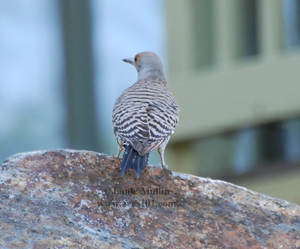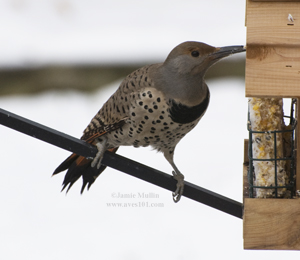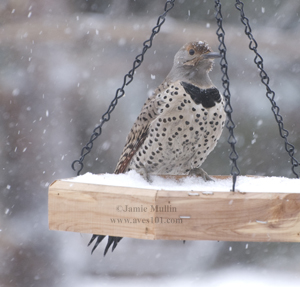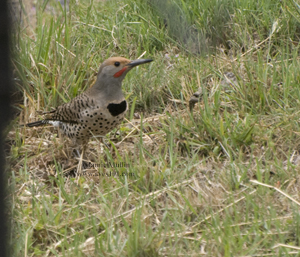Northern Flicker
Order: Piciformes
Family: Picidae
Genus: Colaptes
Species: auratus
**audio coming soon**
Description
-
Length: 12.5"
-
Wing span: 20"
-
Weight: 4.6 oz (130 grams)
-
Medimu to large sized woodpecker with a black and tan striped back
-
Black crescent/shield on chest obvious
-
white rump, and orangish-red patches on underside of wings
-
Black spotted belly
-
Males and females look alike except that the male has a red strip on the malar **Top 7 photos is the Female and bottom most photo is a juvenile female. The rest of them are males**
-
Juveniles resemble the adults
***Northern Flickers from the Western and Eastern regions hybridize where their ranges overlap and it is not uncommon to see hybrid adults. Here are some examples of Hybrid adults (click on the word HYBRIDS to view the photos)***
Factoids:
- A common ant-eating woodpecker of open areas, the Northern Flicker has two color forms found in different regions. The yellow-shafted form is common across the eastern and northern parts of North America, while the red-shafted form is the one found in the West
- Although it can climb up the trunks of trees and hammer on wood like other woodpeckers, the Northern Flicker prefers to find food on the ground. Ants are its favorite food, and the flicker digs in the dirt to find them. It uses its long barbed tongue to lap up the ants
- The red-shafted and yellow-shafted forms of the Northern Flicker formerly were considered different species. The two forms hybridize extensively in a wide zone from Alaska to the panhandle of Texas. A hybrid often has some traits from each of the two forms and some traits that are intermediate between them. The Red-shafted Flicker also hybridizes with the Gilded Flicker, but less frequently, and the Gilded Flicker is considered a separate species
- The Northern Flicker is one of the few North American woodpeckers that is strongly migratory. Flickers in the northern parts of the range move south for the winter, although a few individuals often stay rather far north
All photographs and audio clips are ©Jamie Mullin 2006
Sources: Cornell Lab of Ornithology & The Sibley Guide to Birds.
 |
|---|
 |
 |
 |
 |
 |
 |
 |
 |
 |
 |
 |
 |